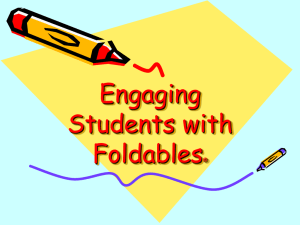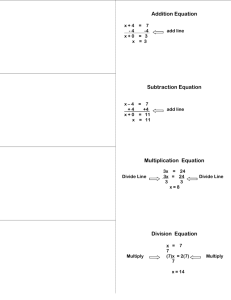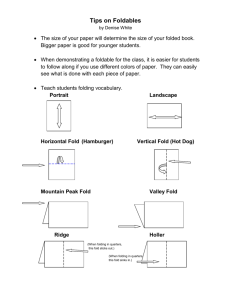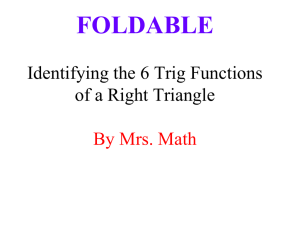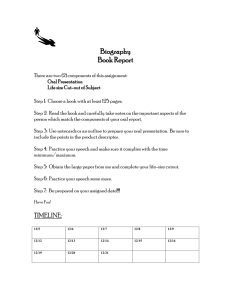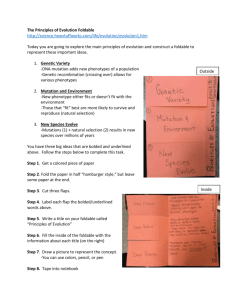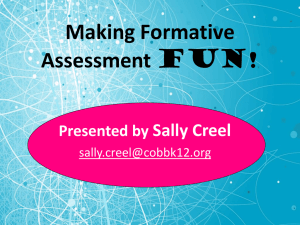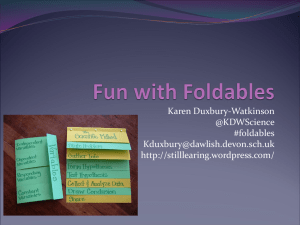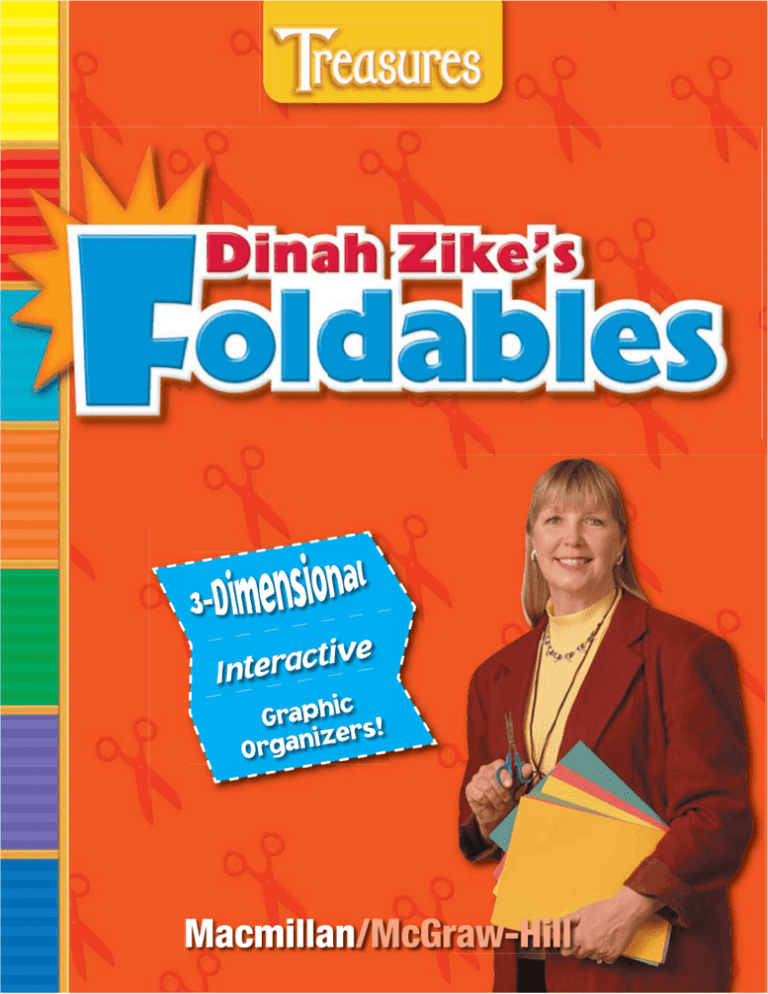
e
v
i
t
c
a
r
Inte
c
Graphi rs!
ze
Organi
ve
i
t
c
a
r
e
Int
c
Graphi rs!
ze
Organi
A
Published by Macmillan/McGraw-Hill, of McGraw-Hill Education, a division of The McGraw-Hill Companies, Inc.,
Two Penn Plaza, New York, New York 10121.
Copyright © by Macmillan/McGraw-Hill. All rights reserved. The contents, or parts thereof, may be reproduced in print form
for non-profit educational use with Treasures, provided such reproductions bear copyright notice, but may not be reproduced
in any form for any other purpose without the prior written consent of The McGraw-Hill Companies, Inc., including, but not
limited to, network storage or transmission, or broadcast for distance learning.
Printed in the United States of America
1 2 3 4 5 6 7 8 9 005 10 11 10 09 08 07
TM
What are Foldables ?
Foldables are multi-dimensional graphic
organizers that can be used for
skills reinforcement, practice,
and/or information organizing.
TM
Why use Foldables ?
Not only do Foldables reinforce
skills and strategies essential
for reading success, they
provide a kinesthetic tool
for organizing and
analyzing learning.
Foldables
3
Dear Teacher,
A Foldable is a three-dimensional, studentmade (and/or teacher-made) interactive
graphic organizer based upon a skill. Making
a Foldable gives students a fast, kinesthetic
activity that helps them organize and retain
information either before, during, or after
reading. In this section of the Teacher’s
Resource Book, you will find instructions for
making Foldables, as well as ideas on how to
use them to reinforce and practice phonics, vocabulary, spelling,
and comprehension skills.
In this section, you will find Foldables to help you
• replace photocopied activity sheets with student-generated
print
• present content and skills in a clear, visual, kinesthetic format
• incorporate the use of such skills as comparing and
contrasting, recognizing cause and effect, and finding
similarities and differences
• assess student progress and learning levels
• immerse students in new and previously learned vocabulary
and reading skills
• teach students unique ways to make study guides and
practice materials, and
• provide students with a sense of ownership in their learning.
I am excited to hand these Foldable ideas and activities over to
you and your students. Have fun using, adding to, and amending
them to meet individual needs.
Sincerely,
4
Foldables
Creating and Storing Foldables
TM
As you use the Foldables outlined in this Teacher’s Resource Book,
discuss with students how they can adapt them to make their own
Foldables learning and study aids. Teach students to write—titles,
vocabulary words, concepts, skills, questions, main ideas—on the
front tabs of their Foldables. By doing this, key concepts are viewed
every time a st udent looks at a Foldable. Foldables help students
focus on and remember the information presented without being
distracted by other print. Remind students to write more specific
information—supporting ideas, examples of a concept, definitions,
answers to questions, observations—under the tabs.
Turn one-gallon freezer bags into student portfolios and storage
containers for Foldables.
Cut the bottom corners off each bag so they won’t
hold air and will stack and store easily.
Write student names across the top of the plastic
portfolios with a permanent marker and cover the
writing with two-inch clear tape to keep it from
wearing off.
Place a piece of cardboard inside each portfolio to
give it strength and to act as a divider.
Store Foldables in a giant laundry soap box. Or,
students can carry their portfolios in a three-ring
binder if you place a strip of two-inch clear tape
along one side and punch three holes through the
taped edge.
Foldables
5
TM
in this section
Basic Shapes ................................................... 7
Foldables™ at a Glance .................................... 8
Answer Mitt (with student copying master) .... 10
Picture Frame ................................................ 12
Shutter ........................................................... 14
Four Door ...................................................... 16
Pocket............................................................ 18
Standing Cube ............................................... 20
Layered Book ................................................ 22
Large Word Study Book ................................. 24
Matchbook ..................................................... 26
Two- and Three-tab ....................................... 28
Four- and Eight-tab ........................................ 32
Accordion Book ............................................. 36
Pyramid ......................................................... 38
Folded Tables and Charts ............................. 40
Foldables Correlated to Reading Skills .......... 42
6
Foldables
Basic Shapes
by Dinah Zike
These figures illustrate the basic folds that are referred to throughout the following
section of this book.
Taco Fold
Hot Dog Fold
Hamburger Fold
Burrito Fold
Valley Fold
Shutter Fold
Mountain Fold
Foldables
7
Foldables At a Glance
TM
by Dinah Zike
Picture Frame
Foldable
Answer Mitt Foldable
Shutter Foldable
the
has wolf
teetbig
h
Pocket Foldable
olf
the w gry
is hun
Standing Cube Foldable
8
Four-Door Foldable
Layered Book Foldable
Large Word Study
Book Foldable
Foldables
Two-Tab Foldable
Matchbook Foldable
c an
c an
a
Three-Tab Foldable
Four-Tab Foldable
Eight -Tab
Foldable
Accordion Foldable
Pyamid Foldable
.VMUJQMF.FBOJOH
8PSET
8PSE%FGJOJUJPO%FGJOJUJPO
Folded Tables
and Charts
Foldables
9
Answer Mitt Foldable
TM
by Dinah Zike
Materials:
• Copying Master on page 39
• scissors
• glue stick
• colored paper
Directions:
1. Copy the pattern onto colored paper.
2. Have children fold the mitt so the fingertips touch each other.
3. Then have children cut out the mitt shape.
4. Have them cut along the fold an inch or so in from the bottom
edge. They may then fold up the flaps.
5. To complete the mitt, have children glue the thumbs of the mitt
together so a pocket is formed. They may also glue the edges
of the wrist flaps to make holders for letter cards.
C
U
Using the Answer Mitt Foldable
TM
For any skills instruction, children can use the mitt to answer
questions that have two possible responses. The mitt can be used
with letter cards or picture cards (from pages 66 –87 of this book),
yes/no cards, and word cards (from pages 90–149 of this book).
When children use the Answer Mitt Foldable in whole class or small
group instruction, you will be better able to monitor their progress.
10
Foldables
Foldables
11
Using the Picture Frame Foldable
TM
by Dinah Zike
Vocabulary and Phonics/Spelling Applications
Students can glue pictures or draw pictures in the frame to
reinforce a vocabulary word or concept. On the inside of the book,
they can write or dictate sentences about the word or concept.
Comprehension Application
To reinforce character study, have students illustrate a story
character and write or dictate sentences about the character.
The same sort of activity can be done with the following skills:
• Setting/plot
• Main idea/details
• Retelling a scene
Grammar Application
Have students use the frame to illustrate a noun or a verb. Then
have them write or dictate sentences about the word.
5IFDPX
FBUT
HSBTT
12
Foldables
Picture Frame Foldable
TM
by Dinah Zike
Materials:
• one sheet of 8½ 11 paper in a bright color
• one sheet of 11 17 paper
• scissors
• glue
Directions:
1. Fold the 8½ 11 paper into a hot
dog.
2. Starting at the fold, cut a frame
shape (as illustrated). Set aside.
3. Fold the 11 17 paper into a
hamburger.
4. Glue the paper frame to the front
side of the hamburger.
Foldables
13
Using the Shutter Foldable
TM
by Dinah Zike
Phonemic Awareness/Phonics/Spelling Application
Use the Shutter Foldable to review contractions and compound words
with students. The outside panels can be used to demonstrate the
two parts of the word. Students can use the middle inside panel to
write out the contraction or complete compound word.
Comprehension Application
There are many ways to use the Shutter Foldable to review and
study comprehension skills. Larger paper can be used so that a
small group or a class can create one of these for literacy study.
Consider having students retell or summarize the story on the
middle inside panel. Then have them use the outer panels to
analyze the following:
• Facts and Opinions (for nonfiction)
• Cause and Effect
• Before and After
• Fantasy and Reality
• Pros and Cons (for persuasion)
• Problem and Solution
• Compare and Contrast
• Phonics for Primary Grades
JTOPU
'BDU
0QJOJPO
Large Shutter Foldables can be stored in
an empty (and clean!) pizza box.
14
Foldables
Shutter Foldable Directions
TM
by Dinah Zike
Materials:
• 8½ 11 paper
Directions:
1. Begin as if you are going to
make a hamburger fold, but
instead of folding the paper,
pinch it to show the midpoint.
2. Open the sheet. Fold both of the
outside edges in to touch the middle
mark.
Use this Foldable to
Foldables
15
Using the Four-Door Foldable
TM
by Dinah Zike
Grammar Application
Use this Foldable for information occurring in four categories. Have
students create study guides and review grammar concepts such
as four types of sentences. They may label each door with a type
of sentence, then define each type and provide an example inside
each door.
TUBUFNFOU
DPNNBOE
RVFTUJPO
FYDMBNBUJP
O
Comprehension Application
When students are reading a selection, they can use this Foldable
to record and store information for summarizing. Have students
write descriptions and include illustrations inside the four doors.
Guide them to choose four categories of information. For example:
• who, what, when, where
• what, where, when, why/how
• character, plot, setting, conflict and resolution
16
XIP
XIBU
XIFSF
XIFO
Foldables
Four-Door Foldable Directions
TM
by Dinah Zike
Materials:
• sheet of 11″ 17″ paper
• scissors
Directions:
1. Make a shutter fold.
2. Fold the shutter fold in half like a
hamburger. Crease well.
3. Open the folds and cut along the inside valley fold lines.
4. These cuts will form four doors on the
inside of the book.
Use this Foldable to
Foldables
17
Using the Pocket Foldable
TM
by Dinah Zike
Vocabulary and Phonics/Spelling Applications
Have students use this Foldable as a study aid. Copies of word
cards can be sorted and stored by students as they learn words.
Have students label the pockets as shown below. As they study the
words, have them move the cards to the appropriate pockets.
XPSE
DBSET
5PP
&BTZ
5PP
)BSE
+VTU
3JHIU
5PP
&BTZ
XPSE
DBSET
5PP
)BSE
XPSE
DBSET
+VTU
3JHIU
Comprehension Application
When students are comparing and contrasting ideas in a selection,
they can use this Foldable to record and store information for
retelling or summarizing. This works with skills such as:
• Fact and opinion
• Make and confirm predictions
• Cause and Effect
• K-W-L
BV`Z
1SFEJDUJPOT
$POGJSN
1SFEJDUJPOT
Send this Foldable home with
students so they can review and sort
words with family members.
Heavy stock paper will improve
durability. Post the Foldable on a
bulletin board for use during workstation
18
Foldables
Pocket Foldable Directions
TM
by Dinah Zike
Materials:
• one 11 17 sheet of paper
• glue
Directions:
1. Begin as if you are going to make
a hot dog, but only fold over about
three inches.
2. With the paper horizontal and the
fold on the bottom, fold the right
side toward the center, trying to
cover one half of the paper. Then,
fold the left side over the right side
to make three sections.
3. Glue the right and left edges of the
original fold so that three pockets
are created.
Foldables
19
Using the Standing Cube Foldable
TM
by Dinah Zike
Vocabulary Application
Use the Foldable for developing vocabulary concepts with students.
Each side of the cube can show information about a word (definition,
example sentences, picture, etc.).
Phonemic Awareness/Phonics Application
With the class, create a Foldable for each letter of
the alphabet. Have students help by providing the
content for each side: words that begin or end with
the letter-sound, and handwriting models for capital
and lowercase letters.
Comprehension Application
Have students work in small groups to create
a Foldable about a story character they are
studying. Each side of the Foldable should
illustrate or tell about character traits.
4THHEW
HAS OLF
BIIGG
TEEETTB
HH
DVQ D
BQ
MJQ U
JQ
O LF
4TH EWGGRRYY
N
N
HUU
ISH
Grammar Application
Use the Foldable to collect and share types of nouns or adjectives.
The Standing Cube Foldable can be
flattened for easier storage or for
moving it into a display area.
20
Foldables
Standing Cube Foldable Directions
TM
by Dinah Zike
Materials:
• two sheets of 11 17 paper
• glue
Directions:
1. Fold each sheet like a hamburger, but fold
one side one-half inch shorter than the
other side.
2. Fold the long side over the short side on
both sheets of paper, making tabs.
3. On one of the folded papers, place a small
amount of glue along the tab, next to the
valley but not in it.
4. Place the non-folded edge of the second
sheet of paper square into the valley and
fold the glue-covered tab over this sheet of
paper. Press flat until the glue holds. Repeat
with the other side.
5. Allow the glue to dry completely before
continuing. After the glue has dried, collapse
the cube flat to write or draw on each side.
Foldables
21
Using the Layered Book Foldable
TM
by Dinah Zike
Vocabulary Application
Have students create this Foldable to help them review vocabulary
words. Have them write a word on each tab and then flip the tab to
write the definition. The same thing can be done with antonyms and
synonyms.
Phonics/Spelling Application
A review/study guide of letter sounds and word parts can be done
with this Foldable. For example:
• Vowels
• Prefixes and suffixes
• Base words
• Digraphs (th, wh, sh, ch)
7PXFMT
B
F
J
P
V
#BTF8PSET
TUSPOH
GBTU
IJHI
TNBMM
Comprehension Application
Use the Foldable to aid in the following skills reinforcement:
• Character study (one tab per story character)
• Summarize/Retelling
• Generating and asking questions
.PUIFSUP5JHFST
$IBSBDUFS4UVEZ
8IZEJETIFMJLFUJHFST
#JH#FBS
.JEEMF#FBS
4NBMM#FBS
(PMEJMPDLT
)PXEJETIFDBSFGPSUIFN
8IBUXBTUIFNPTUDIBMMFOHJOH
8IFOEJEUIFDVCTHPUPUIF[PP
Study Skills and Grammar Applications
This Foldable can be used to review/reinforce concepts studied.
22
Foldables
Layered Book Foldable Directions
TM
by Dinah Zike
Materials:
• two sheets of 8½ 11 paper
• glue
Directions:
1. Stack two sheets of paper so that the back
sheet is one inch higher than the front
sheet.
2. Bring the bottom of both sheets upward
and align the edges so that all of the layers
or tabs are the same distance apart.
3. When all tabs are an equal distance
apart, fold the papers and crease well.
4. Open the papers and glue them
together along the valley, or inner
center fold, or staple them along the
mountain.
If you need more layers, use
additional sheets of paper. Make the
tabs smaller than one inch.
Use this Foldable to
Foldables
23
Using the Large Word Study Book Foldable
TM
by Dinah Zike
Vocabulary and Phonics/Spelling Applications
With a small group, make a Foldable for vocabulary word
study/review. Display the book in a workstation for repeated
review. The size and the format also make it easy for you and
students to use them as lap flashcards.
DBO
)CANRUNFAST
7ECANGOHOME
#ANWEGOPLAY
BUFTUUPTFFIPX
TPNFUIJOHXPSLT
FYQFSJNFOU
5IFTDJFOUJTUEJEBO
FYQFSJNFOUUPTFFXIBULJOE
PGGPPENJDFQSFGFS
Students can make individual books using this Foldable.
Collect and use these books through the
year. Store each large book in a labeled
legal-size folder.
24
Foldables
Large Word Study Book Foldable Directions
TM
by Dinah Zike
Materials:
• several sheets of 11 17 paper (one sheet for each word
studied)
• stapler
Directions:
1. Fold each sheet like a hot dog,
but fold one side one inch shorter
than the other side.
2. Stack the sheets so the folds are
side by side.
3. Staple sheets together along the tabbed end (the bottom of the
pages).
You can make a large word study
book as an aid for vocabulary or spelling word lists. On the front of each
tab, write a vocabulary or spelling word. Open the tab and write the
definition and a sample sentence.
Use this Foldable to
Foldables
25
Using the Matchbook Foldable and Portfolio
TM
by Dinah Zike
Vocabulary Application
With students, create Foldables for weekly vocabulary. Write the
vocabulary word on the front. Have students write a sentence for
the inside.
5IFEPH
DBOKVNQ
DBO
Phonics/Spelling Application
Use the Foldable for review of phonics and/or spelling words.
Hd[i<LdgYh
\^gV[[Z
EPH
EVDL
\Zb
\^Vci
\ZciaZ
EPXO
\nb
EPMM
EJOPTBVS
Comprehension Application
This Foldable works for reinforcing skills such as:
• Cause and effect
• Making predictions
Study Skills Application
If students are studying a list such as state capitals or even
multiplication tables, the portfolio is a great small group or whole
class review tool.
26
Foldables
Matchbook Foldable and Portfolio Directions
TM
by Dinah Zike
Materials:
• several sheets of 8½ 11 paper
• poster board
• scissors
• glue
Directions:
1. Fold each sheet like a
hamburger, but fold it so
that one side is one inch
longer than the other side.
2. Fold the one-inch tab over the short side
to form an envelope-like fold.
3. Fold each hamburger in half. Cut along
the fold line.
4. Grades K-1: After the content has been added to the front and
inside, post the Foldable on a bulletin board.
5. Grades 2-6: Fold the poster
board like a
hamburger.
Foldables
6. Use the small hamburgers
to record information. Glue
them onto the inside of the
poster board.
27
Using the Two- and Three-Tab Foldable
TM
by Dinah Zike
Phonics/Spelling Application
Use the Three-Tab Foldable as an alternate to Sound Boxes.
Open the tabs and write a CVC word on the bottom paper so
that one letter is shown in each box. Have students practice
blending and decoding words.
DPOTPOBOUWPXFMDPOTPOBOU
NBO
Another option is to cut off one of the tabs so that the
Foldable has two tabs. After step 4, cut off the first tab. Open
the other two tabs and write a CVC word on the bottom paper
so that one letter is shown in each box. For further practice
with letter-sound blending, fold the tabs over to make another
CVC word for decoding.
Q
28
PAT
Q
DBQ
Foldables
Using the Two- and Three-Tab Foldable
TM
by Dinah Zike
Phonics/Spelling Application
Several options adapt this Foldable for prefix, base word, and suffix
study and practice.
Use the Three-Tab Foldable to help students with word parts and
syllabication. Open the tabs and write a base word in the center.
Have students practice decoding words.
EJT
DPWFS
Z
Another option is to cut only one of the valleys (see p. 31) so that
the Foldable has two tabs of unequal size. Open the two tabs and
write a base word on the bottom paper so that one word part is
shown in each box. For further practice with pronunciation and word
identification, fold the tabs over to make another word.
QIPOF
A third option is to make a two-tab variation. Use it to compare two
different phonic/spelling elements such as soft c and hard c, vowel
spellings, or word parts.
TPGU
D
IBSE
D
Directions and diagrams appear on page 31.
Foldables
29
Using the Two- and Three-Tab Foldable
TM
continued
by Dinah Zike
Comprehension Application
Use large poster board and choose a vertical or horizontal
orientation to adapt the Three-Tab Foldable. Use it to create the
following graphic organizers:
CPUI
• Venn Diagram
HXZcZ
4DFOF
• Story Map
4DFOF
• K-W-L Chart
,8-
• Nonfiction text organizer
Directions and diagrams appear on page 31.
30
Foldables
Two- and Three-Tab Foldables Directions
TM
by Dinah Zike
Materials:
• one 8½ 11 sheet of paper or large poster board
• scissors
Directions:
1. Fold the sheet like a hot dog.
2. With the paper horizontal and the fold of the
hot dog at the top, fold the right side toward
the center, to cover one half of the paper.
3. Fold the left side over the right side to make three sections.
4. Open the right and left folds. Place one hand
between the two thicknesses of paper and cut
up the two valleys so there are three tabs.
Options:
• Cut only one of the valleys so the Foldable has
two tabs of unequal size.
• Use large poster board to make a Foldable on which you can
record more information.
Use this Foldable to
Foldables
31
Using the Four- and Eight-Tab Foldable
TM
by Dinah Zike
Phonics/Spelling Application
Adapt the Four-Tab Foldable to review digraphs, blends, and vowel
variant letter-sounds. Open the tabs and write a CCVC or CVCe
word on the bottom paper so that one letter is shown in each box.
Have students practice blending, decoding, and identifying words.
SILENThEv
QUIET
PLEASE
DSBC
CBL
Another option is to make the Foldable with three tabs. At step 3
(see page 34), cut only the first and the third creases so that the
middle tab is twice the size of the other two tabs. Open all three
tabs and write a word with a vowel digraph or a CVVC word on the
bottom paper so that one letter is shown in each box and so that the
middle two letters will be hidden by the middle tab.
EPXO
Or, cut only the first and second tabs and write a word that ends
with double letters or the digraph-ck.
CBDL
32
Foldables
Using the Four- and Eight-Tab Foldable
TM
continued
by Dinah Zike
Vocabulary and Phonics/Spelling Applications
Use the Eight-Tab Foldable to study and review spelling or
vocabulary words. Have students write a word on a tab, open
the tab and draw a picture, write a definition, or write a sample
sentence. Students can also do a cumulative study of one of
the following:
• phonic elements such as blends and digraphs
• suffixes and prefixes
C AN
CJH
DBO
SF
DBU
C AN
A
EJT
DBSFGVM
MFTT
*DBOSVO
VO
TIJQ
DBODBU
IBUNBU
SBO
pre-
OFTT
Comprehension Application
The Eight-Tab Foldable is an ideal tool for comparing two texts.
Have students use the tabs to compare and contrast four elements:
characters, setting, problem, solution. The Foldable is also helpful
for summarizing nonfiction.
'FSO
IBCJUBU
TFUUJOH
setting
food
FOFNJFT
QSPCMFN
PROBLEM
QSFZ
MIGRATION
TPMVUJPO
Foldables
XJOUFS
hibernation
DIBSBDUFST
SOLUTION
MATING
PUIFS
33
Four- and Eight-Tab Foldable Directions
TM
by Dinah Zike
Materials:
• one 8½″ 11″ sheet of paper
• scissors
add these for the Eight-Tab Foldable:
• another 8½″ 11″ sheet of paper
• one large sheet of construction paper
• glue
Directions:
1. Fold a sheet of paper into a hot dog.
2. With the paper horizontal and the fold of
the hot dog at the top, fold the hot dog into
four vertical sections.
3. Open these folds. Place one hand between the folded hot dog and
cut up the three fold lines so there are four
tabs.
4. To make the Eight-Tab Foldable, follow steps 1-3 with a second
sheet of paper. Then fold the construction
paper like a hot dog. Open the
construction paper. Glue the tabbed hot
dogs to the inside so they open like the
pages of a book.
Use this Foldable to
34
Foldables
Using the Accordion Book Foldable
TM
by Dinah Zike
Vocabulary/Vocabulary Strategy Application
Use the Accordion Book Foldable to create vocabulary concept books
for topics such as:
• Shapes
• Colors
• Position words
• Number words
• Word categories (such as food words, weather words, etc.)
This Foldable can also be used to create vocabulary books that record
examples and explanations on topics such as:
• word parts
• prefixes and suffixes
• using context clues
• using a dictionary
Phonemic Awareness/Phonics Application
Use the accordion book to create a letter-sound book or an alphabet
book. The book can also be used to collect and share single lettersound examples.
@@
TT@
$MB
@@
SUFE
4UB
@@ @
F@
%BU
Foldables
"B #C
$D
%E
&F
35
Using the Accordion Book Foldable
TM
continued
by Dinah Zike
Comprehension Application
This Foldable is perfect for post-reading
#FHJOOJOH
4FRVFODF
skills application. Use the book to record
PG
text sequence (first, next, last) or plot
sequence (beginning, middle, end). Try
&WFOUT
color-coding each section so students can
see the sequence clearly.
Children may wish to use this Foldable for publishing their own
stories.
Grammar Application
Like the vocabulary strategy applications above, the accordion book
can be used to collect and share grammar skills such as:
• Nouns (proper nouns, common nouns)
• Action verbs
• Adjectives
@@
TT@
$MB
@@
SUFE
B
U
4
@@@
F@
U
B
%
/PV
OT
7FSC
T
Display in a workstation, center, or
library corner. Store by slipping it into a
binder.
36
Foldables
Accordion Book Foldable Directions
TM
by Dinah Zike
Materials:
• several sheets of 11 17 paper
• glue
Directions:
1. Fold each sheet of paper like a
hamburger, but fold one side half
an inch shorter than the other side.
This will form a tab that is half an
inch long.
2. Fold this tab forward over the
shorter side, then fold it back
away from the shorter piece of
paper. (In other words, fold it the
opposite way.)
3. To form an accordion, glue a
straight edge of one section into
the valley of another section’s tab.
Tips! on end to form an accordion. This
Before gluing, stand the sections
will help you see how to glue the
sections together. Use different
colors of paper to indicate sections
of the book. Always place the extra
tab at the back of the book so you
can add more pages later.
Foldables
37
Using the Pyramid Foldable
TM
by Dinah Zike
Use this Foldable with data occurring in threes.
Vocabulary Application
The Pyramid Foldable can be used to sort and review concepts
studied. For example, review three different inflectional endings
(-s, -e, -ies or -tion, -sion, -cion).
Phonics/Spelling Application
Students can sort words into three categories. Some examples:
• Short vowels (a,e,i) or long vowels (o_e, oa, o)
• Blends (sl, st, sw) or consonant digraphs
• Inflected endings (-s, -e, -ies or -ial, -tion, -ious)
Comprehension Application
Not only can students use the pyramid to record information about
what they read, they can do it in a few different ways. With one
pyramid they can do things such as the following:
• Compare three different story characters
• Create a K-W-L chart
• Record information about story beginning, middle, and end
Students can glue together three pyramids to create small
dioramas depicting scenes (from fiction) and concepts (from
nonfiction).
QMPU
CF
HJO
OJO
H
NJEEMF
DIBSBDUFST
E
FO
TFUUJOH
Several pyramids can be strung together
and hung from the ceiling for a vertical
display.
38
Foldables
Pyramid Foldable Directions
TM
by Dinah Zike
Materials:
• one 8½ 11 sheet of paper
• scissors
• glue
Directions:
1. Fold the sheet
into a taco. Cut
off the excess
rectangular tab
formed by the
fold.
3. Cut one of the
valleys to the
center of the X, or
the midpoint, and
stop. This forms
two triangular flaps.
2. Open the folded
taco and refold
it like a taco the
opposite way to
create an X-fold.
4. Glue one of the
flaps under the
other, forming a
pyramid.
Use this Foldable to
Foldables
39
Using Folded Tables and Charts
by Dinah Zike
Depending upon the amount of data, the table or chart can be
adapted and reformatted.
Vocabulary and Phonics/Spelling Applications
Have students use this Foldable as a study aid. Have
them sort the words into categories and write them in the
appropriate columns.
Vocabulary Strategies Application
Students can study words that have:
• prefixes and suffixes
• more than one meaning
• synonyms and antonyms
Comprehension Application
Tables such as these can be helpful before,
during, and after reading a selection. Students
can set up a simple K-W-L table, a beginningmiddle-end table, or a simple sequence table.
.VMUJQMF.FBOJOH
8PSET
8PSE%FGJOJUJPO%FGJOJUJPO
7B:
Set up Vocabulary or Spelling Word
binders in workstations so that
students have easy access to them.
When loose-leaf paper is used, storage
in a three-ring binder is easy.
40
Foldables
Folded Tables and Charts Directions
by Dinah Zike
Materials:
• one 11″ 17″ sheet of paper
Directions:
1. Fold the number of vertical
columns needed to make
the table (or chart).
2. Fold the horizontal rows
needed to make the table. (If
you use loose-leaf paper, you
may not need to do this step.)
Use this Foldable to
Foldables
41
TM
Vocabulary Strategies
Study Skills
Grammar
4-Door
Shutter
Folded Tables and
Charts
Matchbook ok
Pyramid
Large Word Study Book
Vocabulary (including
Oral Vocabulary)
Accordion Book
Layered Book
Picture Frame
Answer Mitt
Phonics/Phonemic
Awareness Spelling
Four – and Eight – Tab
Standing Cube
Reading Skill
Two – and Three – Tab
Pocket
Correlated to Reading Skills
Reading Comprehension Skills
Asking questions
Before and after
Cause and effect
Character study
Character traits
Classify and
categorize
Compare and contrast
Drawing conclusions
Fact and opinion
Fantasy and reality
Making predictions
Problem and solution
Pros and cons
Record information
Sequence
42
Persuasion
Summarize
Making judgments
Setting
Making
generalizations
Retelling
Generating questions
Plot
Conflict and resolution
Main idea and details
Foldables
Learn More About Dinah Zike’s
, an exclusive feature
Foldables™
of Macmillan/McGraw-Hill and
Glencoe Programs:
Dinah Zike is the author of more than 150 educational books
and supplemental materials. For a catalog of Dinah’s current
publications, as well as info on her keynotes and teacher
workshops, call 1-800-99DINAH (1-800-993-4624), or visit
her Web site at www.dinah.com
Visit www.dzacademy.com to learn about the Dinah Zike
Academy, a trainer-of-trainers facility located in the historic Texas
Hill Country just blocks from Dinah’s home. Discover
how you can become personally trained by Dinah
to be a campus, district, or national trainer helping her teach Foldables, V-K-Vs, and Classroom
Organization strategies to others.
Foldables
43
Announcing Dinah Zike’s two
newest books:
Foldables and V-K-Vs for Phonics, Vocabulary, and Spelling
PreK-2: A Photographic Reference Guide for Kinesthetic Learning.
Foldables and V-K-Vs for Phonics, Vocabulary, and Spelling
Grades 3-6: A Photographic Reference Guide for Kinesthetic Learning.
These 300 page, full-color, reference books illustrate how to teach
basic reading skills through the use of manipulatives. Each book
contains nearly 1,000 color photographs demonstrating how teachers
and students can easily make and use Dinah’s tried-and-true Foldables,
and they introduce her brand new visual-kinesthetic-vocabulary flashcards, or V-K-Vs. Not only will you find grade level specific examples of
activities based on all of Dinah’s classic folds, you will also learn thirty
new folds that are perfect for teaching consonants, vowels, blends,
phonograms, contractions, prefixes, suffixes, homographs, and
much more.
44
Foldables
Dinah Zike’s Classroom
Organization:
It Can Be Done
Dinah’s national bestseller is back, updated, and
in full color. A comprehensive teacher’s guide
to help you creatively manage your time, your
energy, and the materials in your classroom. It
is considered a “must” for elementary teachers
who use Foldables. The practical and effective
ideas in this book have been used by thousands
of teachers to help make life easier and teaching
more effective.
Foldables
45
Teacher’s Notes
46
Foldables
Teacher’s Notes
Foldables
47
Teacher’s Notes
48
Foldables
Teacher’s Notes
Foldables
978-0-02-200933-5
MHID: 0-02-200933-7
1 0 0 0 0
EAN
9 780022 009335
Visit our Web site at www.macmillanmh.com
K-6

